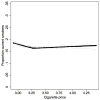Tobacco control policies are egalitarian: a vulnerabilities perspective on clean indoor air laws, cigarette prices, and tobacco use disparities
- PMID: 19282078
- PMCID: PMC2748432
- DOI: 10.1016/j.socscimed.2009.02.003
Tobacco control policies are egalitarian: a vulnerabilities perspective on clean indoor air laws, cigarette prices, and tobacco use disparities
Abstract
This study models independent associations of state or local strong clean indoor air laws and cigarette prices with current smoker status and consumption in a multilevel framework, including interactions with educational attainment, household income and race/ethnicity and the relationships of these policies to vulnerabilities in smoking behavior. Cross sectional survey data are employed from the February 2002 panel of the Tobacco Use Supplement of the Current Population Survey (54,024 individuals representing the US population aged 15-80). Non-linear relationships between both outcome variables and the predictors were modeled. Independent associations of strong clean indoor air laws were found for current smoker status (OR 0.66), and consumption among current smokers (-2.36 cigarettes/day). Cigarette price was found to have independent associations with both outcomes, an effect that saturated at higher prices. The odds ratio for smoking for the highest versus lowest price over the range where there was a price effect was 0.83. Average consumption declined (-1.16 cigarettes/day) over the range of effect of price on consumption. Neither policy varied in its effect by educational attainment, or household income. The association of cigarette price with reduced smoking participation and consumption was not found to vary with race/ethnicity. Population vulnerability in consumption appears to be structured by non-white race categories, but not at the state and county levels at which the policies we studied were enacted. Clean indoor air laws and price increases appear to benefit all socio-economic and race/ethnic groups in our study equally in terms of reducing smoking participation and consumption.
Figures






Similar articles
-
Clean indoor air laws, cigarette excise taxes, and smoking: Results from the current population survey-tobacco use supplement, 2003-2011.Prev Med. 2019 Sep;126:105744. doi: 10.1016/j.ypmed.2019.06.002. Epub 2019 Jun 4. Prev Med. 2019. PMID: 31173803 Free PMC article.
-
What impact have tobacco control policies, cigarette price and tobacco control programme funding had on Australian adolescents' smoking? Findings over a 15-year period.Addiction. 2011 Aug;106(8):1493-502. doi: 10.1111/j.1360-0443.2011.03429.x. Epub 2011 Jun 21. Addiction. 2011. PMID: 21401766
-
The relationships between menthol cigarette preference and state tobacco control policies on smoking behaviors of young adult smokers in the 2006-07 Tobacco Use Supplements to the Current Population Surveys (TUS CPS).Addiction. 2010 Dec;105 Suppl 1:46-54. doi: 10.1111/j.1360-0443.2010.03201.x. Addiction. 2010. PMID: 21059136
-
The economic impact of clean indoor air laws.CA Cancer J Clin. 2007 Nov-Dec;57(6):367-78. doi: 10.3322/CA.57.6.367. CA Cancer J Clin. 2007. PMID: 17989131 Review.
-
The effects of clean indoor air laws: what do we know and what do we need to know?Health Educ Res. 2003 Oct;18(5):592-609. doi: 10.1093/her/cyf045. Health Educ Res. 2003. PMID: 14572019 Review.
Cited by
-
Socioeconomic variation in the prevalence, introduction, retention, and removal of smoke-free policies among smokers: findings from the International Tobacco Control (ITC) Four Country Survey.Int J Environ Res Public Health. 2011 Feb;8(2):411-34. doi: 10.3390/ijerph8020411. Epub 2011 Jan 31. Int J Environ Res Public Health. 2011. PMID: 21556194 Free PMC article.
-
Life Course Changes in Smoking by Gender and Education: A Cohort Comparison Across France and the United States.Popul Res Policy Rev. 2017 Jun;36(3):309-330. doi: 10.1007/s11113-016-9424-y. Epub 2017 Jan 9. Popul Res Policy Rev. 2017. PMID: 29056801 Free PMC article.
-
Effects of tobacco taxation and pricing on smoking behavior in high risk populations: a knowledge synthesis.Int J Environ Res Public Health. 2011 Nov;8(11):4118-39. doi: 10.3390/ijerph8114118. Epub 2011 Oct 26. Int J Environ Res Public Health. 2011. PMID: 22163198 Free PMC article.
-
Differential Relationship between Tobacco Control Policies and U.S. Adult Current Smoking by Poverty.Int J Environ Res Public Health. 2019 Oct 26;16(21):4130. doi: 10.3390/ijerph16214130. Int J Environ Res Public Health. 2019. PMID: 31717748 Free PMC article.
-
Addressing the Social Determinants of Health to Reduce Tobacco-Related Disparities.Nicotine Tob Res. 2015 Aug;17(8):892-7. doi: 10.1093/ntr/ntu266. Epub 2014 Dec 16. Nicotine Tob Res. 2015. PMID: 25516538 Free PMC article. Review.
References
-
- American Lung Association. State of Tobacco Control: 2002. American Lung Association; 2003.
-
- Armour B, Woollery T, Malarcher A, Pechacek T, Husten C. Annual smoking-attributable mortality, years of potential life lost, and productivity losses-United States, 1997–2001. Morbidity and Mortality Weekly Report. 2005;54(25):625–628. - PubMed
-
- Barbeau EM, McLellan D, Levenstein C, DeLaurier GF, Kelder G, Sorensen G. Reducing occupation-based disparities related to tobacco: Roles for occupational health and organized labor. American Journal of Industrial Medicine. 2004;46(2):170–179. - PubMed
Publication types
MeSH terms
Substances
Grants and funding
LinkOut - more resources
Full Text Sources
Medical

